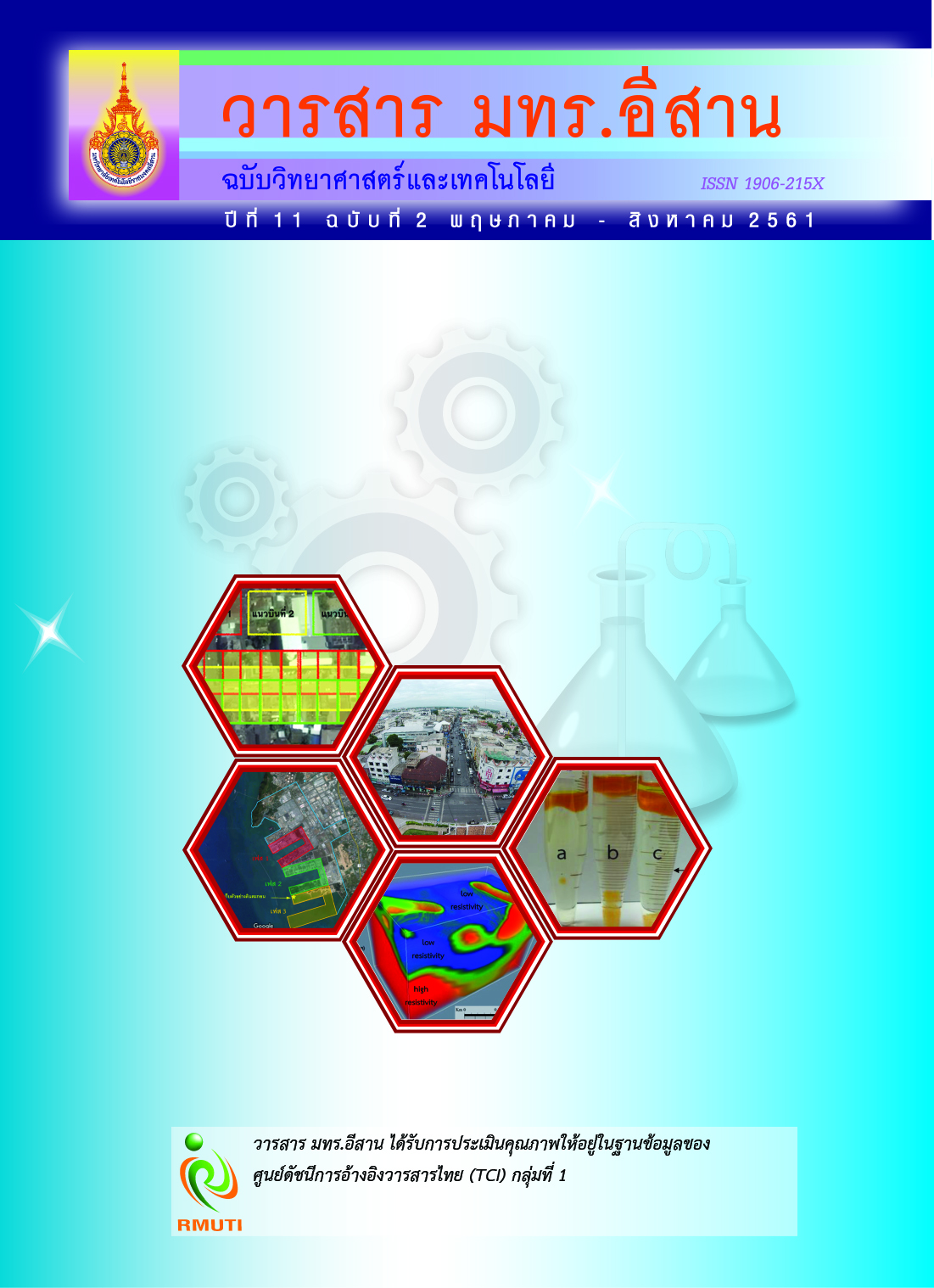การประเมินวอเตอร์ฟุตพริ้นท์ของการผลิตปลาทับทิมจากฟาร์มเพาะเลี้ยงในพื้นที่อำเภอเสนา จังหวัดพระนครศรีอยุธยา
Main Article Content
บทคัดย่อ
การวิเคราะห์ปริมาณการใช้นํ้าของกระบวนการผลิตปลาทับทิมจากฟาร์มเพาะเลี้ยงในอำเภอเสนา จังหวัดพระนครศรีอยุธยา โดยอาศัยแนวคิดวอเตอร์ฟุตพริ้นท์ ซึ่งเป็นเครื่องมือหนึ่งในการวิเคราะห์และบริหารจัดการทรัพยากรน้ำอย่างยั่งยืน โดยมีวัตถุประสงค์เพื่อวิเคราะห์ปริมาณการใช้น้ำต่อหนึ่งหน่วยผลผลิตปลาทับทิมจากฟาร์มเพาะเลี้ยงจำนวน 60 ฟาร์ม ระหว่างเดือนมีนาคม พ.ศ. 2559 ถึงเดือนมกราคม พ.ศ. 2560 ผลการศึกษาพบว่าค่าเฉลี่ยวอเตอร์ฟุตพริ้นท์ของการผลิตปลาทับทิมมีค่าเท่ากับ 4,460.77 ลิตร/ ปลาทับทิม 1 กิโลกรัม ซึ่งมีการใช้ทรัพยากรน้ำตลอดกระบวนการผลิต (บลูวอเตอร์ฟุตพริ้นท์) เท่ากับ 4,213.48 ลิตร/ปลาทับทิม 1 กิโลกรัม และปริมาณนํ้าเสีย (เกรย์วอเตอร์ฟุตพริ้นท์) มีค่าเฉลี่ยเท่ากับ 247.29 ลิตร/ ปลาทับทิม 1 กิโลกรัม ดังนั้นแนวทางการลดปริมาณวอเตอร์ฟุตพริ้นท์จากกระบวนการผลิตปลาทับทิม จากการทำฟาร์มเพาะเลี้ยงจึงควรมุ่งเน้นการเพิ่มประสิทธิภาพของการใช้ทรัพยากรน้ำภายในฟาร์มเพาะเลี้ยง
Article Details
เอกสารอ้างอิง
[2] Fisheries Development Policy and Strategy Division. (2017). Fisheries Statistics of Thailand 2015. Ministry of Agriculture and Cooperatives: Department of Fisheries.
[3] Vanham, D., Hoekstra, A. Y., and Bidoglio, G. (2013). Potential Water Saving Through Changes in European Diets. Environment International. Vol. 61, pp. 45-56. DOI: 10.1016/j.envint.2013.09.011
[4] Polomski, R. F., Bielenberg, D. G., Whitwell, T., Taylor, M. D., Bridges, W. C. and Klaine, S. J. (2008). Differential Nitrogen and Phosphorus Recovery by Five Aquatic Garden Species in Laboratory-Scale Subsurface-Constructed Wetlands. Hort Science. Vol. 43, No. 3, pp. 868-874
[5] FAO. (2012). The State of World Fisheries and Aquaculture. Food and Agriculture Organization of the United Nations, Rome, Italy.
[6] Hoekstra, A. Y. and Chapagain, A. K. (2008). Globalization of Water: Sharing the Planet’s Freshwater Resources. Oxford: Blackwell
[7] Aldaya, M. M., Chapagain, A. K., Hoekstra, A. Y., and Mekonnen, M. M. (2011). The Water Footprint Assessment Manual. Cornwall, UK: T.J. International Ltd.
[8] Boulay, Anne-Marie, Hoekstra, A. Y., and Vionnet, S. (2013). Complementarities of Water-Focused Life Cycle Assessment and Water Footprint Assessment. Environmental Science & Technology. Vol. 47, Issue 21, pp. 11926-11927. DOI: 10.1021/es403928f
[9] Merino, G., Barange, M., Blanchard, J. L., Harle, J., Holmes, R., Allen, I., Allison, E. H., Badjeck, M. C., Dulvy, N. K., Holt, J., Jennings, S., Mullon, C., and Rodwell, L. D. (2012). Can Marine Fisheries and Aquaculture Meet Fish Demand from a Growing Human Population in a Changing Climate?. Global Environmental Change. Vol. 22, Issue 4, pp. 795-806. DOI: 10.1016/j.gloenvcha.2012.03.003
[10] Vanham, D., Mak, T. N., and Gawlik, B. M. (2016). Urban Food Consumption and Associated Water Resources: The Example of Dutch Cities. Science of the Total Environment. Vol. 565, pp. 232-239. DOI: 10.1016/j.scitotenv.2016.04.172
[11] Krejcie, R. V. and Morgan, E. W. (1970). Determining Sample Size for Research Activities. Educational and Psychological Measurement. pp. 607-610. DOI: 10.1177/001316447003000308
[12] Yamane, T. (1973). Mathematics for Economists: An Elementary Survey. (2nd ed). New Delhi: Prentice-Hall.
[13] Chapagain, A. K., Hoekstra, A. Y., Savenije, H. H. G., and Gautam, R. (2006). The Water Footprint of Cotton Consumption: An Assessment of the Impact of Worldwide Consumption of Cotton Products on the Water Resources in the Cotton Producing Countries. Ecological Economics. Vol. 60, Issue 1, pp. 186-203. DOI: 10.1016/j.ecolecon.2005.11.027
[14] Hoekstra, A. Y., Chapagain, A. K., Aldaya, M. M., and Mekonnen, M. M. (2011). The Water Footprint Assessment Manual: Setting the Global Standard. Water Footprint Network: The Netherlands
[15] The Regional Environment Office 13 (Chonburi). (2017). Guide to The Environmental Quality Standards. Environmental Quality Control: Ministry of Natural Resources and Environment.
[16] Mekonnen, M. M. and Hoektra, A. Y. (2011). The Green, Blue and Grey Water Footprint of Crop and Derived Crop Product. Hydrology and Earth System Sciences. Vol. 15, Issue 5, pp. 1577-1600. DOI: 10.5194/hess-15-1577-2011
[17] Rong, H., Li, G., and Zhang, J. (2013). Construction of Demonstration Aquaculture Farms Backed up by Regional Resources Advantage. Hebei Fish. Vol. 230, pp. 56-57
[18] Yuan, Q., Song, G., Fullana-i-Palmer, P., Wang, Y., Semakula, H. M., Mekonnen, M. M., and Zhang, S. (2017). Water Footprint of Feed Required by Farmed Fish in China Based on a Monte Carlo-Supported Von Bertalanffy Growth Model: A Policy Implication. Journal of Cleaner Production. Vol. 153, pp. 41-50. DOI: 10.1016/j.jclepro.2017.03.134
[19] Gjedrem, T., Robinson, N., and Rye, M. (2012). The Importance of Selective Breeding in Aquaculture to Meet Future Demands for Animal Protein: A Review. Aquaculture. Vol. 350, pp. 117-129. DOI: 10.1016/j.aquaculture.2012.04.008
[20] Hess, T., Andersson, U., Mena, C., and Williams, A. (2015). The Impact of Healthier Dietary Scenarios on the Global Blue Water Scarcity Footprint of Food Consumption in the UK. Food Policy. Vol. 50, pp. 1-10. DOI: 10.1016/j.foodpol.2014.10.013
[21] Verdegem, M. C. J. and Bosma, R. H. (2009). Water Withdrawal for Brackish and Inland Aquaculture, and Options to Produce more Fish in Ponds with Present Water Use. Water Policy. Vol. 11, Issue S1, pp. 52-68. DOI: 10.2166/wp.2009.003
[22] Pahlow, M., van Oel, P. R., Mekonnen, M. M., and Hoekstra, A. Y. (2015). Increasing Pressure on Freshwater Resources due to Terrestrial Feed Ingredients for Aquaculture Production. Science of the Total Environment. Vol. 536, pp. 847-857. DOI: 10.1016/j.scitotenv.2015.07.124


